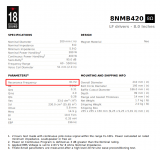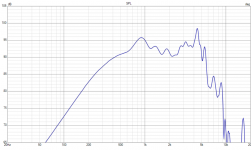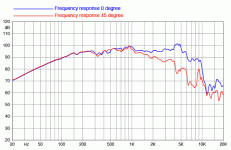When you look at the baffle diffraction of a similar size and shape measured on the drivers axis added together with dibirama's IB measurements it looks about right.
18sound's own measurements look nothing like this, strange.


18sound's own measurements look nothing like this, strange.
Not sure what/who's measurements you are refering to, but I don't see much of a 1.5k dip there. My mid is close to the top of the baffle, that should smooth it out a bit in the diffraction sim. (flat part of my baffle is 40cm high and 30cm wide, with 10cm radius on the sides).
I'm pretty sure the dip is not baffle related, since I tried it in many configurations with the dip still present.
I have nothing to compare to, so I'll just have to wait to get the replacement driver for the 16ohm I sent back.
I'm pretty sure the dip is not baffle related, since I tried it in many configurations with the dip still present.
I have nothing to compare to, so I'll just have to wait to get the replacement driver for the 16ohm I sent back.
One way is to take several nearfield measuremens, midpoint and 2-3 towards edge. Cardboard fastening semipermanently might be difficult.
Perhaps what seems obvious to me needs more explaining.Not sure what/who's measurements you are refering to, but I don't see much of a 1.5k dip there. My mid is close to the top of the baffle, that should smooth it out a bit in the diffraction sim. (flat part of my baffle is 40cm high and 30cm wide, with 10cm radius on the sides).
I'm pretty sure the dip is not baffle related, since I tried it in many configurations with the dip still present.
I have nothing to compare to, so I'll just have to wait to get the replacement driver for the 16ohm I sent back.
The measurement of the 8NMB420 I showed the image of is from dibirama another site similar to hificompass with lots of useful measurements. There are a couple of subtle dips above and below 1500Hz seen in those, but there is also a 2kHz peak.
In a baffle as wide as yours the point of the baffle diffraction dip after the main diffractive hump is at 1500Hz, even if there is no significant dip itcreates a sort of hinge point, with the baffle adding below 1500Hz and the driver itself creating a peak at 2Khz. The two peaks either side make what looks like a dip but really it is two peaks with the point where the diverge being 1500Hz.
So if you add on the diffraction features of the baffle size together with the driver response seen in the dibirama measurements it would look very much like what you measured.
The baffle isn't causing a dip but it is creating a hump below 1500Hz. This happens sometimes you get two features creating peaks that you weren't expecting which then look like a dip and go chasing for something causing cancellation when that isn't the cause.
I get what you are saying, but it's not really what I found when testing baffles. I tried to investigate it to understand it, and took a lot of measurements with various baffle shapes (as in pics) and no baffle, to find the pattern (same as playing around with the sim) but I could not see the different baffles having much effect on the dive at 1.5k.. The major diff seemed to be what happened below 1k.
Cone concavity and profile are important, not only to minimize resonances, but to make on vs off axis responses more even. This is also main reason for differences in simulation vs. measured response, because all simulations use pistonic (flat) radiating surface. same problem happens in dome tweeteers vs. dimple dome vs. concaves (like Focal), but at around 15kHz
Manufactures use different dustcaps and "phase plugs" for this same reason, in mids and midwoofers. Bowl-like profile is used by Accuton. A fine example of this is in FineCone demo that I linked earlier. 3-way woofers use different dustcaps mainly to control cone resonances. 1-3kHz is critical range, because ears are most sensitive there, and often MT crossover is there too. Modern narrow enclosurers often make problmes in this range too, sadly.
Wide or extremely narrow boxes can help with this.
https://audioxpress.com/article/speaker-cones-fabrication-materials-and-performance
Manufactures use different dustcaps and "phase plugs" for this same reason, in mids and midwoofers. Bowl-like profile is used by Accuton. A fine example of this is in FineCone demo that I linked earlier. 3-way woofers use different dustcaps mainly to control cone resonances. 1-3kHz is critical range, because ears are most sensitive there, and often MT crossover is there too. Modern narrow enclosurers often make problmes in this range too, sadly.
Wide or extremely narrow boxes can help with this.
https://audioxpress.com/article/speaker-cones-fabrication-materials-and-performance
Yes, it could be that it's a cone-related problem, I will try to investigate that later. It bugs me though that it seems others have measured better, and it kind of contradicts that it would be related to cone geometry. Maybe I should also try to vary the mic distance a bit to see what happens.
yes. This makes sense to me, and matches up with my experience.The baffle isn't causing a dip but it is creating a hump below 1500Hz. This happens sometimes you get two features creating peaks that you weren't expecting which then look like a dip and go chasing for something causing cancellation when that isn't the cause.
FYI, 1500Hz is ~22cm long. Datasheet says Sd 220cm2 which makes diameter of ~17cm, which is ~2000Hz.
Dip in response would require the driver not being pistonic or some secondary sound come opposite phase, like half wavelength late. This could be edge diffraction, but as you already tried to rule it out it could be reflection inside the cab, or from the measurement jig? Or, perhaps edge of the cone is moving opposite phase or not moving at all? In other words the driver is not pistonic there for some reason. I wonder if the dip goes away if you "burn-in" the speaker by stretching the moving parts properly?
See this recent discussion, https://www.diyaudio.com/community/...ld-a-new-driver-be.391669/page-2#post-7161026 , it took some stretch by hand to get TS parameters align that of the datasheet. Your impedance plot shows Fs closer to 70Hz than 61Hz of datasheet. Datasheet impedance plot shows impedance peak even lower, which is funny 🙂
Dip in response would require the driver not being pistonic or some secondary sound come opposite phase, like half wavelength late. This could be edge diffraction, but as you already tried to rule it out it could be reflection inside the cab, or from the measurement jig? Or, perhaps edge of the cone is moving opposite phase or not moving at all? In other words the driver is not pistonic there for some reason. I wonder if the dip goes away if you "burn-in" the speaker by stretching the moving parts properly?
See this recent discussion, https://www.diyaudio.com/community/...ld-a-new-driver-be.391669/page-2#post-7161026 , it took some stretch by hand to get TS parameters align that of the datasheet. Your impedance plot shows Fs closer to 70Hz than 61Hz of datasheet. Datasheet impedance plot shows impedance peak even lower, which is funny 🙂
Attachments
Last edited:
I tried adding more damping in the cabinet, no diff, I tried it 'open baffle' (with only the cardboard, and bare driver only. I also let it play LF sine and pink noise for a couple of hours. Same result.
I did however see some change when I put small pieces of sticky butyl on the outer roll of the surround. Three pieces were very small with a diam under 2mm. This is why I was leaning to the surround and possibly diffraction from the plastic ring around the driver which is also similar inner diameter with a straight edge (no rounding/chamfer).
I have adapted the habit of 'massaging' the spiders when it comes to break in, but I have only observed lower FS, not altered frequency response in the midrange from break in.
I did however see some change when I put small pieces of sticky butyl on the outer roll of the surround. Three pieces were very small with a diam under 2mm. This is why I was leaning to the surround and possibly diffraction from the plastic ring around the driver which is also similar inner diameter with a straight edge (no rounding/chamfer).
I have adapted the habit of 'massaging' the spiders when it comes to break in, but I have only observed lower FS, not altered frequency response in the midrange from break in.
Regarding Fs, the impedance curves were taken on 'virgin' drivers, it's the first thing I checked after unboxing. Sadly I overlooked reading the labels on the boxes, or I would have seen that one was marked 16ohms 🙂
Anyway, I don't see Fs as an issue here, they will not play that low, and I have the option to run them aperiodic. (I have a slit in the rear of the box that is tightly stuffed at the moment).
Anyway, I don't see Fs as an issue here, they will not play that low, and I have the option to run them aperiodic. (I have a slit in the rear of the box that is tightly stuffed at the moment).
For sure, I thought that higher than specified Fs usually tells stiff surround/spider that requires some breakin. If its the surround that is stiff it might affect how the cone/moving parts behave when non pistonic frequency range and perhaps cause deviation to specsheet frequency response. Never seen anyone tell about such problems on forums so, perhaps this is not an issue. If you don't find a problem then try this one, last hope 😀
edit. Certainly, haven't seen very well behaving 8" mids although its long time I compared them. Here is my 8" faital pro mid in leaky cardioid box. Specsheet response is "as good as others" but in reality the response without smoothing is bumpy ride. They've been like this after few years of use so I think its not going anywhere, perhaps I should try the massaging as well. But, luckily its about the same to all directions on the pass band so nothing DSP wouldn't fix. Passive xo, nah, wouldn't even consider.
edit. Certainly, haven't seen very well behaving 8" mids although its long time I compared them. Here is my 8" faital pro mid in leaky cardioid box. Specsheet response is "as good as others" but in reality the response without smoothing is bumpy ride. They've been like this after few years of use so I think its not going anywhere, perhaps I should try the massaging as well. But, luckily its about the same to all directions on the pass band so nothing DSP wouldn't fix. Passive xo, nah, wouldn't even consider.
Attachments
Last edited:
I have done some measurements, some crazier than others, so I will be posting them here.
This is various mic. distances,1m to 5cm.Gain was varied, so it's not easy to tell which is which, except the one with the one with the 3.7k dip is 5cm

This is various mic. distances,1m to 5cm.Gain was varied, so it's not easy to tell which is which, except the one with the one with the 3.7k dip is 5cm
Maybe something to do with cone geometry after all.. It seems the only big difference is with the ugly dust cap 🙂
- Home
- Loudspeakers
- Multi-Way
- Full size 3-way project


